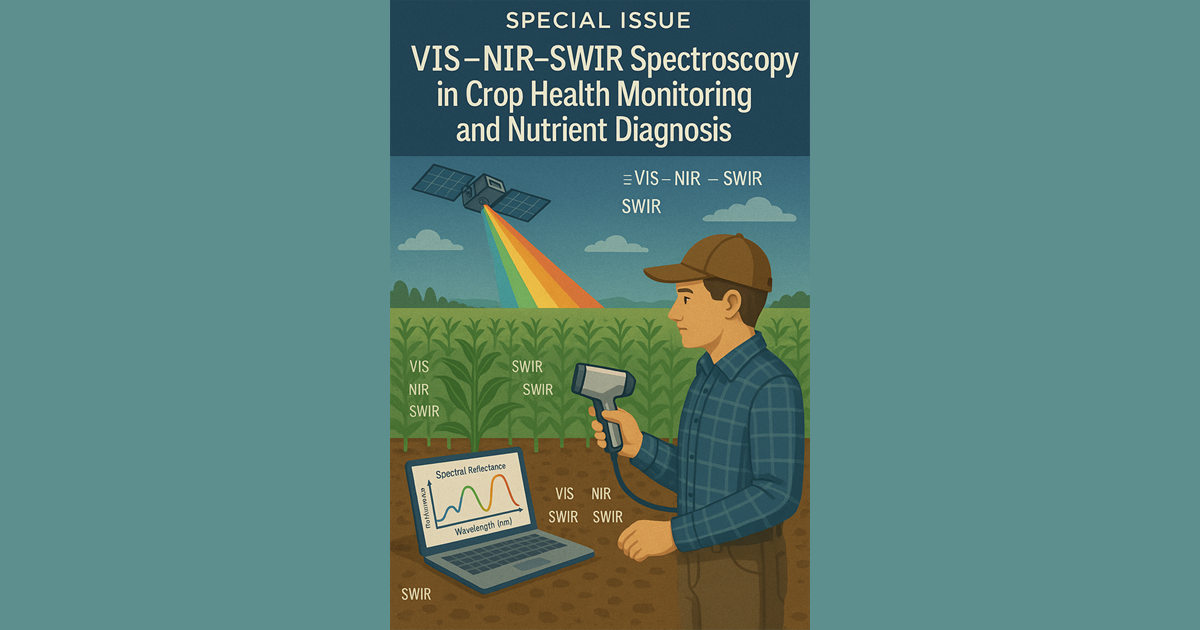Applications of VIS-NIR-SWIR Spectroscopy in Crop Health Monitoring and Nutrient Diagnosis
A special issue of Agriculture (ISSN 2077-0472). This special issue belongs to the section "Artificial Intelligence and Digital Agriculture".
Deadline for manuscript submissions: 5 November 2025 | Viewed by 245

Special Issue Editors
Interests: agrimechatronics; robotics; machine learning; mechanical vibrations; wireless sensors network; Internet of Things
Special Issues, Collections and Topics in MDPI journals
Special Issue Information
Dear Colleagues,
The early 2000s marked a turning point with the expansion of Visible (VIS), Near-Infrared (NIR), and Shortwave Infrared (SWIR) applications, driven by improved sensor sensitivity and data acquisition speed. Researchers began developing multivariate calibration models and employing chemometric techniques to extract biochemical information related to nitrogen, phosphorus, and other key nutrients. In parallel, the adoption of hyperspectral imaging enabled the spatial mapping of stress responses and nutrient variability at the canopy and leaf levels. More recently, the integration of spectroscopy with machine learning and remote sensing platforms (e.g., unmanned aerial vehicles (UAVs) and satellites) has significantly enhanced the scalability and accuracy of crop diagnostic tools. Today, VIS-NIR-SWIR spectroscopy stands at the forefront of precision agriculture, enabling proactive, data-driven crop management strategies.
This Special Issue aims to bring together cutting-edge research and applied innovations focused on the use of VIS-NIR-SWIR spectroscopy for crop health monitoring and nutrient diagnosis. The Special Issue seeks to explore how these spectral techniques, spanning wavelengths from approximately 400 to 2500 nm, are advancing non-destructive, real-time, and high-throughput approaches to assess physiological and biochemical traits in crops.
We invite contributions that address fundamental and applied aspects of VIS-NIR-SWIR spectroscopy across various agricultural systems, including open-field farming, greenhouse production, and controlled environment agriculture. Emphasis will be placed on the development and validation of spectral indices, chemometric and machine learning models, sensor fusion strategies, and the integration of spectroscopy with remote sensing platforms (e.g., UAVs, satellites, proximal sensors).
Topics of interest include, but are not limited to, the following:
- Development and validation of spectral indices and chemometric models for nutrient estimation (e.g., N, P, K, micronutrients);
- Detection and quantification of biotic and abiotic stresses using spectral signatures;
- Integration of spectroscopy with machine learning, radiative transfer modeling, and digital twin frameworks;
- Hyperspectral and multispectral imaging in controlled and open-field environments;
- Real-time (on-the-go) decision support systems;
- Sensor fusion and data assimilation for real-time decision support systems;
- Remote and proximal sensing platforms (UAVs, satellites, ground-based systems) for large-scale crop monitoring.
This Special Issue welcomes original research articles, methodological studies employing qualitative, quantitative, or mixed approaches, empirical investigations, and comprehensive review papers.
Dr. Sulaymon Eshkabilov
Dr. Galibjon Sharipov
Guest Editors
Manuscript Submission Information
Manuscripts should be submitted online at www.mdpi.com by registering and logging in to this website. Once you are registered, click here to go to the submission form. Manuscripts can be submitted until the deadline. All submissions that pass pre-check are peer-reviewed. Accepted papers will be published continuously in the journal (as soon as accepted) and will be listed together on the special issue website. Research articles, review articles as well as short communications are invited. For planned papers, a title and short abstract (about 100 words) can be sent to the Editorial Office for announcement on this website.
Submitted manuscripts should not have been published previously, nor be under consideration for publication elsewhere (except conference proceedings papers). All manuscripts are thoroughly refereed through a single-blind peer-review process. A guide for authors and other relevant information for submission of manuscripts is available on the Instructions for Authors page. Agriculture is an international peer-reviewed open access semimonthly journal published by MDPI.
Please visit the Instructions for Authors page before submitting a manuscript. The Article Processing Charge (APC) for publication in this open access journal is 2600 CHF (Swiss Francs). Submitted papers should be well formatted and use good English. Authors may use MDPI's English editing service prior to publication or during author revisions.
Keywords
- crop health monitoring
- nutrient diagnosis
- remote sensing
- UAVs
- satellites
- machine learning
- hyperspectral and multispectral imaging
- integration of spectroscopy
- decision support systems
- sensor fusion
- chemometric models
- biotic and abiotic stresses
- VIS-NIR-SWIR spectroscopy
Benefits of Publishing in a Special Issue
- Ease of navigation: Grouping papers by topic helps scholars navigate broad scope journals more efficiently.
- Greater discoverability: Special Issues support the reach and impact of scientific research. Articles in Special Issues are more discoverable and cited more frequently.
- Expansion of research network: Special Issues facilitate connections among authors, fostering scientific collaborations.
- External promotion: Articles in Special Issues are often promoted through the journal's social media, increasing their visibility.
- Reprint: MDPI Books provides the opportunity to republish successful Special Issues in book format, both online and in print.
Further information on MDPI's Special Issue policies can be found here.






